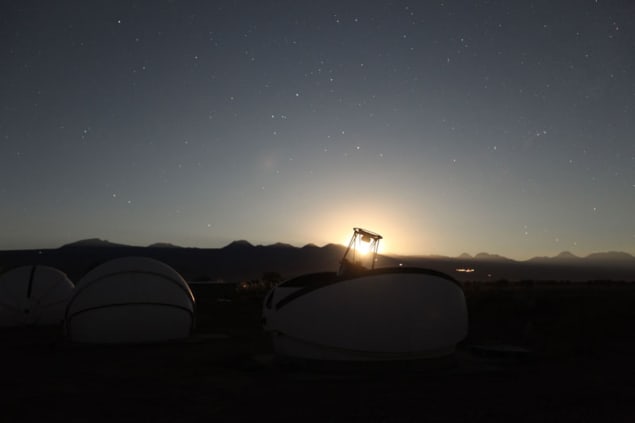
A chance encounter with light from a distant star has given astronomers a wealth of information about Eris – a “dwarf planet” that is currently almost 100 times further from the Sun than the Earth. By using multiple telescopes to watch Eris move in front of the star, an international team of scientists has worked out the diameter of the dwarf planet and measured its ability to reflect light. The observations reveal that Eris is about the same size as Pluto, but denser and shinier, with the shininess suggesting that Eris is covered with a millimetre-thick layer of ice that renews itself in a 500-year cycle.
Discovered in 2005, Eris is one of the furthest known objects in the solar system. By studying the relative motion of Eris and its accompanying moon Dysnomia, astronomers have already worked out that Eris is about a quarter of the mass of our own Moon, making it about 27% heavier than Pluto. Astronomers therefore had thought that Eris also has a larger diameter than Pluto – but could not get any reliable estimates because Eris is so far away that it is just a point of light to even the most powerful telescopes.
Vanishing act
Now, however, Bruno Sicardy of the LESIA Observatoire de Paris and colleagues have used several telescopes in South America to track Eris as it moved between a star and Earth, revealing that Eris is in fact about the same size as Pluto. When such an occultation occurs, observers along a narrow path on the Earth’s surface see the star vanish for up to a minute – much like a solar eclipse. By measuring the time that the starlight is blocked at several different points on the path, the team can work out the radius of Eris. According to Sicardy, the main challenge is not making the measurements, but rather predicting exactly when and where the occultation will be visible.
This time the team’s painstaking calculations paid off because three telescopes in Chile – two at San Pedro de Atacama and the other several hundred kilometres away at La Silla – saw a pronounced dip in the light from the star as Eris moved across it in November 2010. A fourth telescope in Argentina, a few hundred kilometres from La Silla, did not see any dip – and together this information allowed the team to work out the diameter of Eris to be somewhere between 2314 and 2338 km. This is more accurate than our current estimate for the diameter of Pluto (2300–2400 km), which is complicated by blurring caused by Pluto’s atmosphere. Indeed, the occultation study could find no evidence of an atmosphere on Eris.
By measuring the light from Eris during the occultation, the team was also able to determine how much sunlight is reflected from its surface. The researchers were able to confirm previous observations that Eris is very shiny, showing that it has a “visible geometric albedo” of 0.96. This is much greater than Pluto’s, which is about 0.6. The shininess comes as a surprise because, thanks to its exposure to the solar wind, Eris was expected to be much darker.
Sublimating froth
Sicardy believes that the high albedo is caused by an extremely thin layer of frozen nitrogen “froth” just one millimetre thick on the surface of Eris. Although Eris is now nearly 100 astronomical units (AU) from the Sun, it has a very eccentric orbit that will bring it as close as 38 AU in about 250 years. As it nears the Sun, Sicardy believes that the thin layer of nitrogen will sublimate to create an atmosphere much like that of Pluto. When Eris then moves away from the Sun, the gas will refreeze to create a shiny new surface. Mike Brown from the California Institute of Technology, who was part of the team that discovered Eris, agrees with this idea of renewal. “It seems a very natural hypothesis to explain both the high albedo and the lack of apparent surface variations,” he says.
When the new result is combined with the known mass of Eris, it suggests that the density of the dwarf planet is about 2.5 g/cm3 – compared with Pluto at 2.0 and 5.5 for the Earth. According to Sicardy, this means that Eris is mostly rock covered in a 100 km thick layer of frozen nitrogen and methane. Pluto, on the other hand appears to have less rock and more ice. Brown, who was not involved in this latest work, says he finds “the remarkably high amount of rock in the interior of Eris compared to Pluto” to be “the most surprising thing” about the observation.
The observations are described in Nature 478 493.



